Anti-Inflammatory and Protein Tyrosine Phosphatase 1B Inhibitory Metabolites from the Antarctic Marine-Derived Fungal Strain Penicillium glabrum SF-7123
Abstract
1. Introduction
2. Results and Discussion
2.1. Isolation and Structure Determination of Compounds 1–5
2.2. Effects of Secondary Metabolites Isolated from SF-7123 on the Production of Pro-Inflammatory Mediators
2.3. Effect of Compound 2 on NF-κB and Mitogen-Activated Protein Kinase (MAPK) Pathways
2.4. PTP1B Inhibitory Effects of the Isolated Metabolites 1–5
3. Experimental
3.1. General Experimental Procedures
3.2. Fungal Material and Fermentation
3.3. Extraction and Isolation of Compounds 1–5
3.4. Cell Culture and Viability Assay
3.5. Nitrite Determination
3.6. Preparation of Cytosolic and Nuclear Fractions
3.7. Western Blot Analysis
3.8. DNA-Binding Activity of NF-κB
3.9. PGE2 Assay
3.10. Quantitative Real-Time Reverse-Transcription PCR (qRT-PCR)
3.11. PTP1B Assay
3.12. Statistical Analysis
4. Conclusions
Supplementary Materials
Author Contributions
Funding
Conflicts of Interest
References
- Ebada, S.S.; Proksch, P. Marine-Derived Fungal Metabolites; Kim, S.K., Ed.; Springer: Berlin/Heidelberg, Germany, 2015; pp. 759–788. [Google Scholar]
- Jin, L.; Quan, C.; Hou, X.; Fan, S. Potential Pharmacological Resources: Natural Bioactive Compounds from Marine-Derived Fungi. Mar. Drugs 2016, 14, 76. [Google Scholar] [CrossRef] [PubMed]
- Rateb, M.E.; Ebel, R. Secondary metabolites of fungi from marine habitats. Nat. Prod. Rep. 2011, 28, 290–344. [Google Scholar] [CrossRef] [PubMed]
- Block, M.L.; Zecca, L.; Hong, J.S. Microglia-mediated neurotoxicity: Uncovering the molecular mechanisms. Nat. Rev. Neurosci. 2007, 8, 57–69. [Google Scholar] [CrossRef] [PubMed]
- Sugama, S. Stress-induced microglial activation may facilitate the progression of neurodegenerative disorders. Med. Hypotheses 2009, 73, 1031–1034. [Google Scholar] [CrossRef] [PubMed]
- Lappas, M.; Permezel, M.; Georgiou, H.M.; Rice, G.E. Nuclear factor kappa B regulation of proinflammatory cytokines in human gestational tissues in vitro. Biol. Reprod. 2002, 67, 668–673. [Google Scholar] [CrossRef] [PubMed]
- Amor, S.; Puentes, F.; Baker, D.; van der Valk, P. Inflammation in neurodegenerative diseases. Immunology 2010, 129, 154–169. [Google Scholar] [CrossRef]
- Lue, L.F.; Kuo, Y.M.; Beach, T.; Walker, D.G. Microglia activation and anti-inflammatory regulation in Alzheimer’s disease. Mol. Neurobiol. 2010, 41, 115–128. [Google Scholar] [CrossRef]
- Long-Smith, C.M.; Sullivan, A.M.; Nolan, Y.M. The influence of microglia on the pathogenesis of Parkinson’s disease. Prog. Neurobiol. 2009, 89, 277–287. [Google Scholar] [CrossRef]
- Tsunekawa, T.; Banno, R.; Mizoguchi, A.; Sugiyama, M.; Tominaga, T.; Onoue, T.; Hagiwara, D.; Ito, Y.; Iwama, S.; Goto, M.; et al. Deficiency of PTP1B Attenuates Hypothalamic Inflammation via Activation of the JAK2-STAT3 Pathway in Microglia. EBioMedicine 2017, 16, 172–183. [Google Scholar] [CrossRef]
- Erdnikovs, S.; Abdala-Valencia, H.; Cook-Mills, J.M. ndothelial cell PTP1B regulates leukocyte recruitment during allergic inflammation. Am. J. Physiol. Lung Cell Mol. Physiol. 2013, 304, 240–249. [Google Scholar] [CrossRef]
- Song, G.J.; Jung, M.; Kim, J.H.; Park, H.; Rahman, M.H.; Zhang, S.; Zhang, Z.Y.; Park, D.H.; Kook, H.; Lee, I.K.; et al. A novel role for protein tyrosine phosphatase 1B as a positive regulator of neuroinflammation. J. Neuroinflamm. 2016, 13, 86. [Google Scholar] [CrossRef] [PubMed]
- Tanada, Y.; Mori, K. Synthesis and absolute configuration of (-)-neuchromenin, a neurotrophic metabolite of Eupenicillin javanicum var. meloforme, and its enantiomer. Eur. J. Org. Chem. 2001, 2001, 1963–1966. [Google Scholar] [CrossRef]
- Hayakawa, Y.; Yamamoto, H.; Tsuge, N.; Seto, H. Structure of a new microbial metabolite, neuchromenin. Tetrahedron Lett. 1996, 37, 6363–6364. [Google Scholar] [CrossRef]
- Tanada, Y.; Mori, K. Synthesis and absolute configuration of Nocardione A and B, furano-o-naphthoquinone-type metabolites of nocardia sp with antifungal, cytotoxic, and enzyme inhibitory activities. Eur. J. Org. Chem. 2001, 2001, 4313–4319. [Google Scholar] [CrossRef]
- Liao, W.Y.; Shen, C.N.; Lin, L.H.; Yang, Y.L.; Han, H.Y.; Chen, J.W.; Kuo, S.C.; Wu, S.H.; Liaw, C.C. Asperjinone, a nor-neolignan, and terrein, a suppressor of ABCG2-expressing breast cancer cells, from thermophilic Aspergillus terreus. J. Nat. Prod. 2012, 75, 630–635. [Google Scholar] [CrossRef]
- Ohashi, H.; Akiyama, H.; Nishikori, K.; Mochizuki, J. Asterric acid, a new endothelin binding inhibitor. J. Antibiot. 1992, 45, 1684–1685. [Google Scholar] [CrossRef]
- Yuan, C.; Wang, H.Y.; Wu, C.S.; Jiao, Y.; Li, M.; Wang, Y.Y.; Wang, S.Q.; Zhao, Z.T.; Lou, H.X. Austdiol, fulvic acid and citromycetin derivatives from an endolichenic fungus, Myxotrichum sp. Phytochem. Lett. 2013, 6, 662–666. [Google Scholar] [CrossRef]
- Sassa, T.; Nukina, M.; Suzuki, Y. Deoxyfunicone, a New γ-Pyrone Metabolite from a Resorcylide-producing Fungus (Penicillium sp). Agric. Biol. Chem. 1991, 55, 2415–2416. [Google Scholar]
- Singh, S.B.; Jayasuriya, H.; Dewey, R.; Polishook, J.D.; Dombrowski, A.W.; Zink, D.L.; Guan, Z.; Collado, J.; Platas, G.; Pelaez, F.; et al. Isolation, structure, and HIV-1-integrase inhibitory activity of structurally diverse fungal metabolites. J. Ind. Microbiol. Biotechnol. 2003, 30, 721–731. [Google Scholar]
- Zhang, H.; Shan, Y.; Wu, Y.; Xu, C.; Yu, X.; Zhao, J.; Yan, J.; Shang, W. Berberine suppresses LPS-induced inflammation through modulating Sirt1/NF-κB signaling pathway in RAW264.7 cells. Int. Immunopharmacol. 2017, 52, 93–100. [Google Scholar] [CrossRef]
- Jung, E.H.; Hwang, J.S.; Kwon, M.Y.; Kim, K.H.; Cho, H.; Lyoo, I.K.; Shin, S.; Park, J.H.; Han, I.O. A tryptamine-paeonol hybridization compound inhibits LPS-mediated inflammation in BV2 cells. Neurochem. Int. 2016, 100, 35–43. [Google Scholar] [CrossRef]
- Siebenlist, U.; Franzoso, G.; Brown, K. Structure, regulation and function of NF-kappa B. Annu. Rev. Cell Biol. 1994, 10, 405–455. [Google Scholar] [CrossRef]
- Karin, M.; Ben-Neriah, Y. Phosphorylation meets ubiquitination: The control of NF-[kappa]B activity. Annu. Rev. Immunol. 2000, 18, 621–663. [Google Scholar] [CrossRef]
- Ghosh, S.; May, M.J.; Kopp, E.B. NF-kappa B and Rel proteins: Evolutionarily conserved mediators of immune responses. Annu. Rev. Immunol. 1998, 16, 225–260. [Google Scholar] [CrossRef]
- Liu, Y.; Shepherd, E.G.; Nelin, L.D. MAPK phosphatases--regulating the immune response. Nat. Rev. Immunol. 2007, 7, 202–212. [Google Scholar] [CrossRef]
- Dong, C.; Davis, R.J.; Flavell, R.A. MAP kinases in the immune response. Annu. Rev. Immunol. 2002, 20, 55–72. [Google Scholar] [CrossRef]
- Na, M.; Tang, S.; He, L.; Oh, H.; Kim, B.S.; Oh, W.K.; Kim, B.Y.; Ahn, J.S. Inhibition of protein tyrosine phosphatase 1B by ursane-type triterpenes isolated from Symplocos paniculata. Planta Med. 2006, 72, 261–263. [Google Scholar] [CrossRef]
- Zhang, W.; Hong, D.; Zhou, Y.; Zhang, Y.; Shen, Q.; Li, J.; Hu, L.; Li, J. Ursolic acid and its derivative inhibit protein tyrosine phosphatase 1B, enhancing insulin receptor phosphorylation and stimulating glucose uptake. Biochem. Biophys. Acta 2006, 1760, 1505–1512. [Google Scholar] [CrossRef] [PubMed]
- Cho, K.H.; Kim, D.C.; Yoon, C.S.; Ko, W.M.; Lee, S.J.; Sohn, J.H.; Jang, J.H.; Ahn, J.S.; Kim, Y.C.; Oh, H. Anti-neuroinflammatory effects of citreohybridonol involving TLR4-MyD88-mediated inhibition of NF-кB and MAPK signaling pathways in lipopolysaccharide-stimulated BV2 cells. Neurochem. Int. 2016, 95, 55–62. [Google Scholar] [CrossRef] [PubMed]
- Hamaguchi, T.; Sudo, T.; Osada, H. RK-682, a potent inhibitor of tyrosine phosphatase, arrested the mammalian cell cycle progression at G1phase. FEBS Lett. 1995, 372, 54–58. [Google Scholar] [CrossRef]


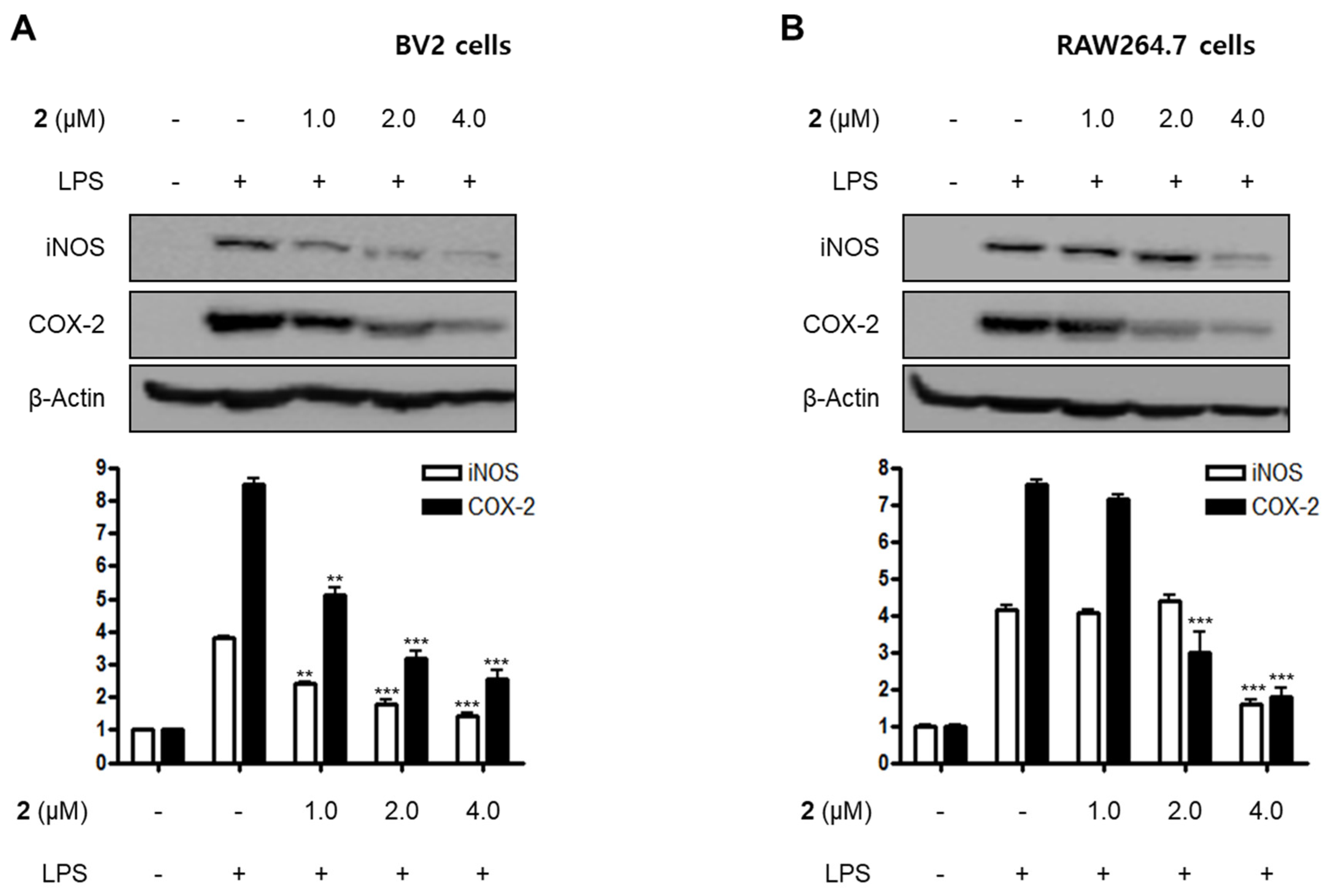
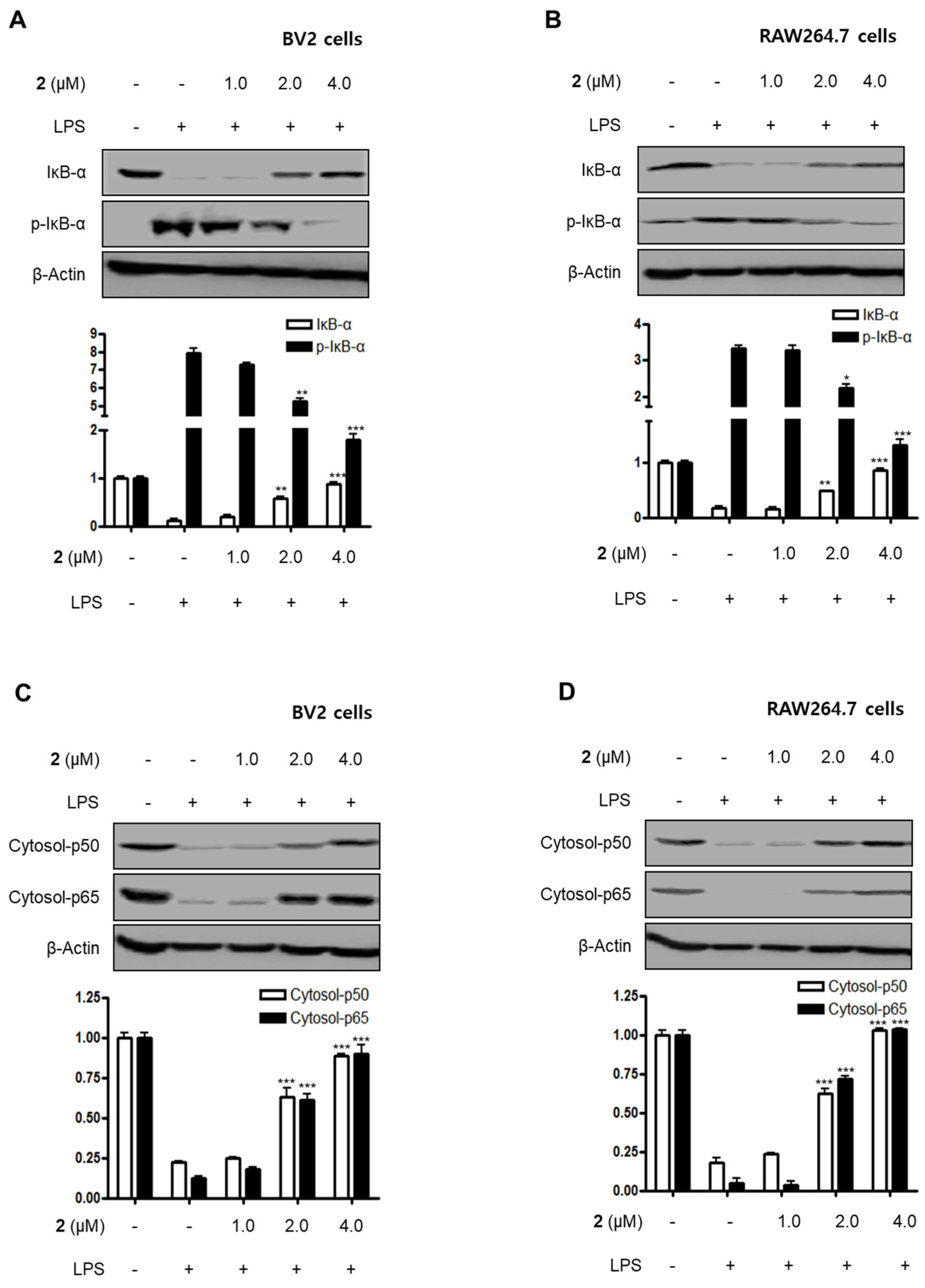
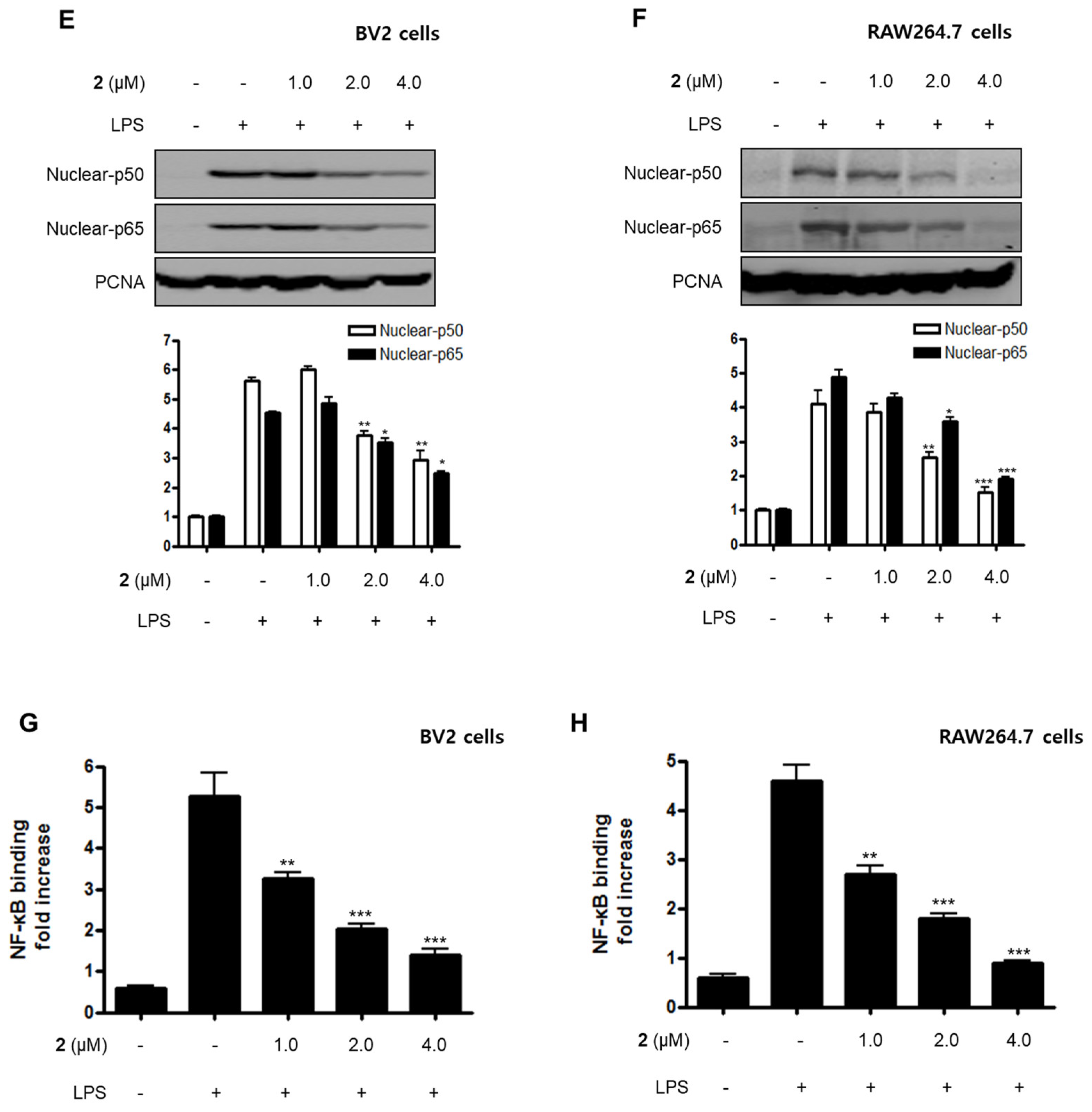
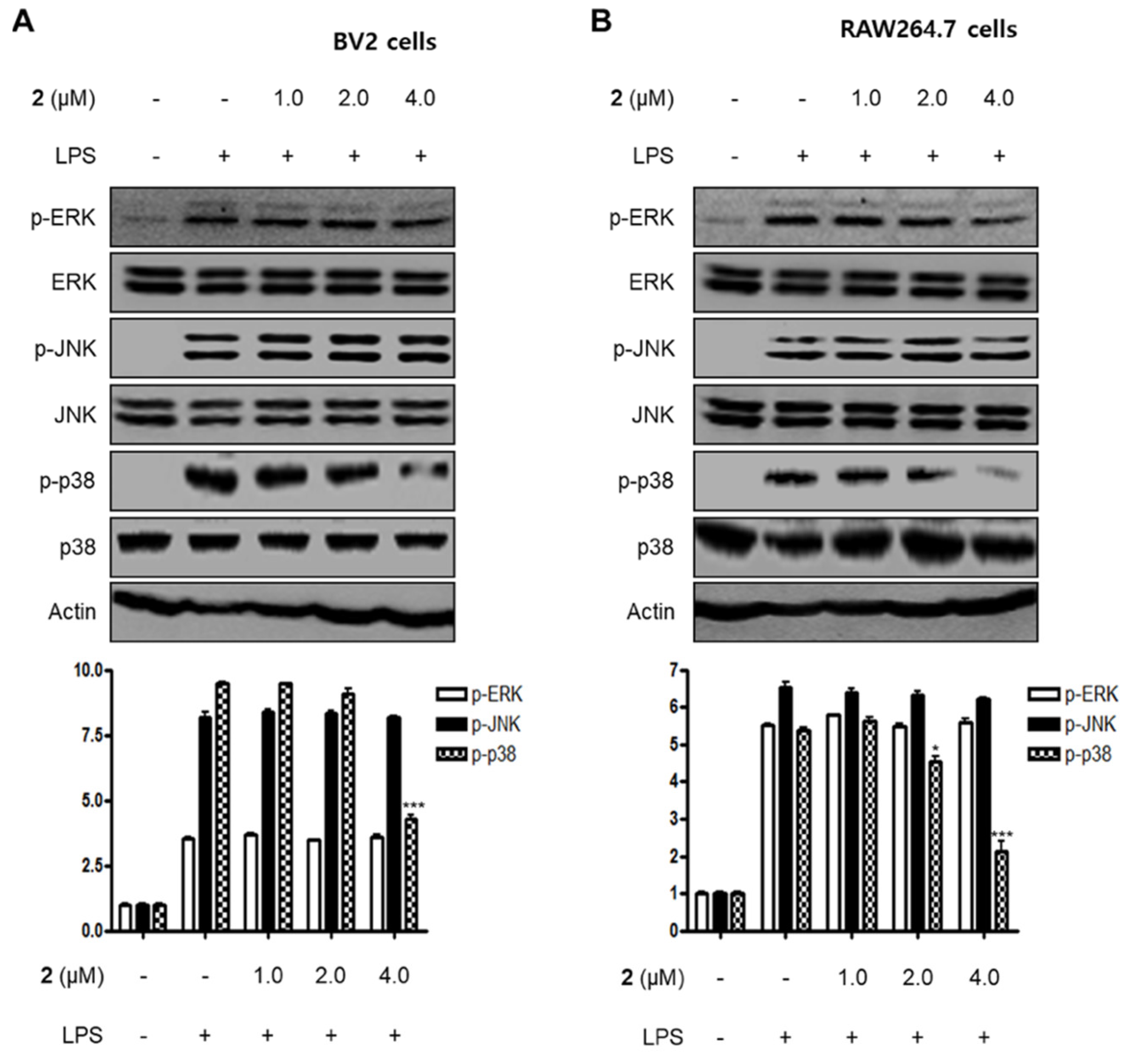
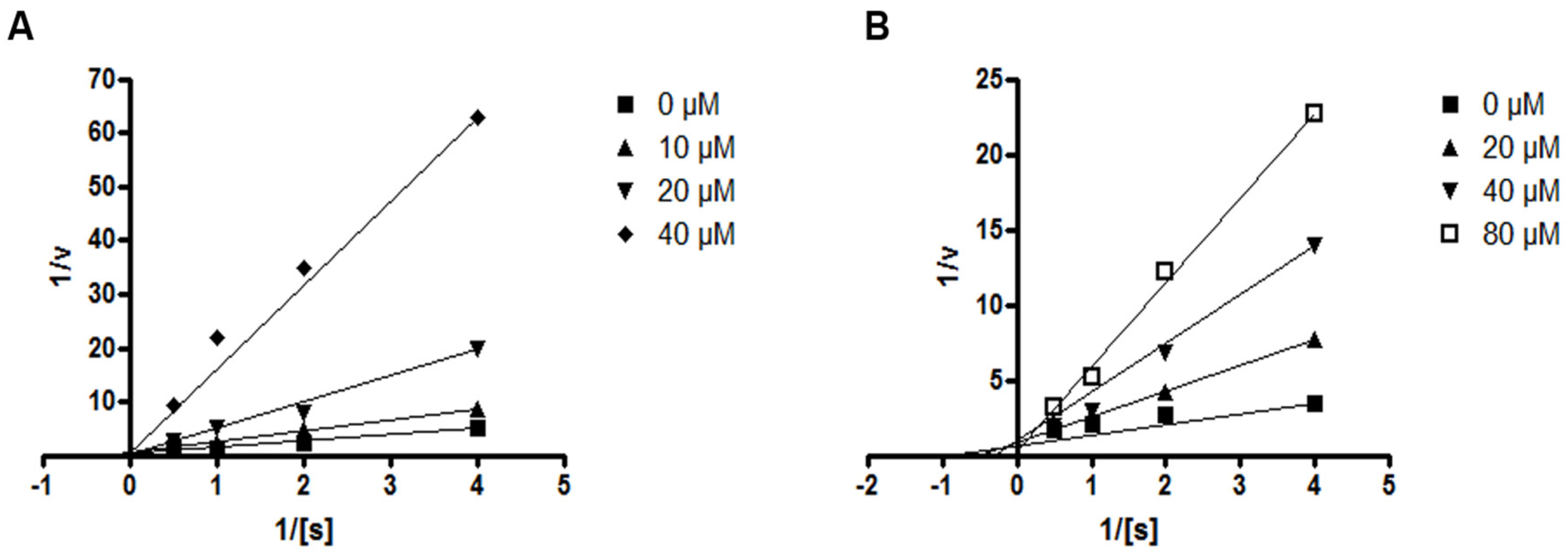
| Position | δCa,b | δH a,c (mult, J in Hz) | HMBC |
|---|---|---|---|
| 2 | 77.3 | 4.72 (m) | |
| 3 | 43.5 | 2.53 (m) | 2, 4, 11 |
| 4 | 191.0 | - | - |
| 4a | 102.4 | - | - |
| 5 | 64.1 | 5.03 (d, 12.0),4.73 (d, 12.0) | 4, 4a, 6a, 10b |
| 6a | 156.3 | - | - |
| 7 | 104.8 | 6.34 (s) | 6a, 8, 9, 10, 10b |
| 8 | 154.5 | - | - |
| 9 | 144.8 | - | - |
| 10 | 108.9 | 7.06 (s) | 6a, 8, 9, 10, 10b |
| 10a | 107.9 | - | |
| 10b | 165.7 | - | - |
| 11 | 20.6 | 1.55 (d, 6.4) | 2, 3, 4 |
| 12 | 57.0 | 3.83 (s) | 9 |
| Compounds | NO Inhibitory Effects a | PGE2 Inhibitory Effects a | ||
|---|---|---|---|---|
| BV2 Cells | RAW264.7 Cells | BV2 Cells | RAW264.7 Cells | |
| 1 | >80 | >80 | >80 | 50.2 ± 2.5 |
| 2 | 2.7 ± 0.1 | 4.7 ± 0.2 | 3.2 ± 0.2 | 4.1 ± 0.1 |
| 3 | >80 | >80 | >80 | 53.4 ± 2.7 |
| 4 | 28.1 ± 1.4 | 41.5 ± 2.1 | 25.2 ± 1.3 | 30.0 ± 1.5 |
| 5 | 10.6 ± 0.5 | 40.1 ± 2.0 | 32.3 ± 1.6 | >80 |
| Compounds | Inhibitory Effects on PTP1B a |
|---|---|
| 1 | 45.7% b |
| 2 | 37.8% b |
| 3 | 13.7% b |
| 4 | 19.2 ± 1.0 |
| 5 | 24.3 ± 1.2 |
| Ursolic acid b | 3.1 ± 0.2 |
© 2020 by the authors. Licensee MDPI, Basel, Switzerland. This article is an open access article distributed under the terms and conditions of the Creative Commons Attribution (CC BY) license (http://creativecommons.org/licenses/by/4.0/).
Share and Cite
Ha, T.M.; Kim, D.-C.; Sohn, J.H.; Yim, J.H.; Oh, H. Anti-Inflammatory and Protein Tyrosine Phosphatase 1B Inhibitory Metabolites from the Antarctic Marine-Derived Fungal Strain Penicillium glabrum SF-7123. Mar. Drugs 2020, 18, 247. https://doi.org/10.3390/md18050247
Ha TM, Kim D-C, Sohn JH, Yim JH, Oh H. Anti-Inflammatory and Protein Tyrosine Phosphatase 1B Inhibitory Metabolites from the Antarctic Marine-Derived Fungal Strain Penicillium glabrum SF-7123. Marine Drugs. 2020; 18(5):247. https://doi.org/10.3390/md18050247
Chicago/Turabian StyleHa, Tran Minh, Dong-Cheol Kim, Jae Hak Sohn, Joung Han Yim, and Hyuncheol Oh. 2020. "Anti-Inflammatory and Protein Tyrosine Phosphatase 1B Inhibitory Metabolites from the Antarctic Marine-Derived Fungal Strain Penicillium glabrum SF-7123" Marine Drugs 18, no. 5: 247. https://doi.org/10.3390/md18050247
APA StyleHa, T. M., Kim, D.-C., Sohn, J. H., Yim, J. H., & Oh, H. (2020). Anti-Inflammatory and Protein Tyrosine Phosphatase 1B Inhibitory Metabolites from the Antarctic Marine-Derived Fungal Strain Penicillium glabrum SF-7123. Marine Drugs, 18(5), 247. https://doi.org/10.3390/md18050247




